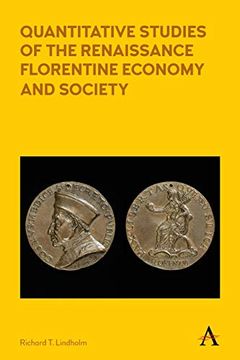Compartir
Quantitative Studies of the Renaissance Florentine Economy and Society (Anthem Other Canon Economics) (en Inglés)
Richard T. Lindholm (Autor)
·
Anthem Pr
· Tapa Blanda
Quantitative Studies of the Renaissance Florentine Economy and Society (Anthem Other Canon Economics) (en Inglés) - Richard T. Lindholm
$ 62.200
$ 103.660
Ahorras: $ 41.460
Elige la lista en la que quieres agregar tu producto o crea una nueva lista
✓ Producto agregado correctamente a la lista de deseos.
Ir a Mis Listas
Origen: Estados Unidos
(Costos de importación incluídos en el precio)
Se enviará desde nuestra bodega entre el
Jueves 30 de Mayo y el
Martes 11 de Junio.
Lo recibirás en cualquier lugar de Chile entre 1 y 3 días hábiles luego del envío.
Reseña del libro "Quantitative Studies of the Renaissance Florentine Economy and Society (Anthem Other Canon Economics) (en Inglés)"
The book is a collection of nine quantitative studies - each probing one aspect of Renaissance Florentine economy and society. These are organized into three parts by topic, source material and analysis methods. Part one, on risk and return, contains two chapters. Chapter 1 studies Florentine plague outbreaks. Recent work has highlighted the incompatibility of evidence from written records with medical evidence. The chapter reconciles these approaches by using financial market evidence to interpret the written records. The next chapter examines a commonly used interest rate time series for Renaissance Florence. Significant literature has evolved during the past quarter century that measures interest rates to assess state formation trends in late medieval and early modern Europe. This chapter links financial theory and medieval law to better measure the Florentine interest rate, showing that the interest rate evidence used to date must be reconsidered.The second part examines Florentine society. This part shows how Florentine occupations can be separated into two categories by comparing wealth levels and distributions; demonstrates that the architectural and artistic explosion during the mid-fifteenth century was the result of a subsidy - a tax loophole that exempted the home and its furnishings from an significant new tax, leading to a transfer of assets into art and architecture; finds that Florentine neighbourhoods remained integrated between the mid-fourteenth and late fifteenth centuries; and provides evidence that the modern life-cycle curve of wealth accumulation might not have held true in Renaissance Florence.The final part looks at work - focusing specifically on the wool industry. It examines the historical structure of Florentine firms and offers a wide range of evidence to demonstrate that the industry's firms were small and perfectly competitive with little monopoly power. It also demonstrates the value of dynamic data in understanding women's work during the late medieval and early modern periods. Finally, it shows that the foundation of the Florentine cloth industry reduced the risk facing the individual company by relying on a combination of a guild organization and the putting-out production system - both systems that are rejected by economic theory as hopelessly inefficient.
- 0% (0)
- 0% (0)
- 0% (0)
- 0% (0)
- 0% (0)
Todos los libros de nuestro catálogo son Originales.
El libro está escrito en Inglés.
La encuadernación de esta edición es Tapa Blanda.
✓ Producto agregado correctamente al carro, Ir a Pagar.

